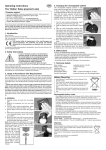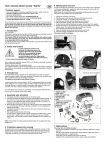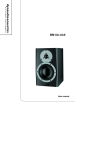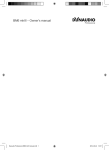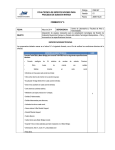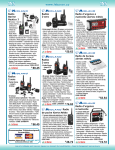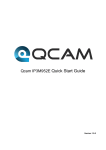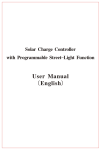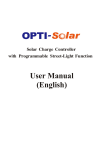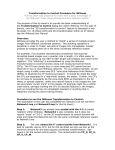Transcript
Operating instructions GB The ‘Corfu’ Solar-powered Standard Lamp Customer support: If you have problems or questions regarding this product, simply contact us! Monday to Friday 8 am to 12 noon and 1 pm to 4 pm. By phone: 09605-92206-27 By e-mail for ordering spare parts: [email protected] By e-mail for questions about the product: [email protected] Product: Manufacturer Item No.: 102072 These instructions relate ONLY to this product and contain important information for using the product for the first time. Please keep these instructions for later reference and should always accompany the product in the event of transference to a new user. 1. Introduction Dear Costumer, Thank you for purchasing the solar light. With this solar light you purchased a product manufactured according to the current state of technology. This product fulfils all requirements of the valid European and national regulations. The conformity was proved. The relevant declarations and documentation are deposited with the manufacturer. To maintain this state and guarantee a safe operation, you as the user will have to follow this operating manual! 2. Safety Instructions ! - In case of damages caused by not following this operating manual, the warranty rights will expire! We exclude liability for any consequential damages! - We exclude liability for property or personal damages caused by inappropriate handling or not following the safety instructions. - In these cases any guarantee rights will expire. Due to safety and admission reasons (CE) it is not allowed to arbitrarily reconstruct and/or change the solar light. Therefore, please keep to the operating manual. The accident prevention rules of the association of the industrial trade cooperative association for electric plants and working material are to be considered in industrial environments 3. Usage in Accordance with Requirements This solar-powered lamp is designed for outdoor use. The built in rechargeable battery is charged by the solar cell in the upper portion of the lamp. The lamp switches itself on automatically when it is getting dark and switches itself off when it is beginning to get light in the morning. A high performance LED (light emitting diode) is used as the light source. This LED provides a discreet flickering light and guarantees a good light intensity while using a small current. -- Please note that the length of time that light is emitted is affected during the winter months and when there is little sunlight falling upon the solar module.-Note: During prolonged periods without any incident solar radiation, the rechargeable battery will be insufficiently charged to ensure that the lamp is always ready for use. This does not however mean that the solar lamp is defective. Wait for the next sunny days and the lamp will again work correspondingly well. Alternatively you can recharge the battery in the intervening time by using a commercially available charger. The lamp should be stored indoors during the winter months and when there is a storm. Please note section 7 – Storing throughout the winter. 4. Operation 1. Carefully remove the lamp from the packaging. 2. Remove the protective film from the solar module. 3. Carefully remove the housing containing the solar module from the lamp basket (Figures 1 and 2). 4. Pull the strips out from the lower part (Figure 3). 5. Place the top part back onto the lamp. 6. Next fit the lamp basket to the pedestal. The solar lamp is now activated. Figure 1 Figure 2 Note: the duration of the light given out is highly dependent on both the intensity and the length of sunlight experienced during the day. On days when there is little sun then the light can normally be expected to be given out for a shorter period of time. Should the lamp still not light on Figure 3 the first evening, then wait until a sunny day or else charge the rechargeable battery using a commercially available charger. 5. Changing the rechargeable batteries The rechargeable batteries present in solar lamps must be changed after an average period of every 2 years. Please only insert identical rechargeable batteries which have the same voltage and the same capacity. Should these rechargeable batteries not be commercially available, then you can also use rechargeable batteries which have a higher capacity. Figure 4 1. Turn the solar module anticlockwise (Figure 4) and remove the upper part (Figure 5). 2. Turn the transparent cover on the underside of the top section anticlockwise and then remove it. 3. Take the used rechargeable batteries from the battery holder and insert a new rechar- Figure 5 geable battery into the battery holder making sure the poles of the battery are connected the right way round (Figure 6). It is advisable to charge the new batteries in a battery charger before inserting them into the lamp. 4. Next reassemble the lamp in the reverse order. Figure 6 Note: used batteries must be disposed of in an environmentally friendly manner and should not be placed in your household waste. Your dealer is obliged by law to take back the old rechargeable batteries. 6. Malfunctions -Lamp is not automatically switched on at darkness - An outside light source (e.g. streetlight) simulates daylight and prevents the lamp from switching on. Place the lamp at a darker location. - Lamp is not switched on at darkness or only for a short period of time. - Is the lamp connected? (see poimt 4.4) - Accumulator weak or defective. Exchange of the accumulators. 7. Storing over the winter The solar lamp should be stored indoors throughout the winter in a frost-free location. The rechargeable battery should be taken out of the lamp and should be charged in a commercially available charger, at the latest when putting the lamp back into operation. 8. Technical details Solar module: Means of illumination: Operating voltage: Rechargeable battery: Period of illumination: crystalline silicon 2 V/ 40 mA 1 yellow light emitting diode (LED) 1.2 V 1.2 V/300 mAh (Mignon, AA-size) maximum 8 hours on a fully charged battery Battery Recycling: - Used batteries or accumulators must be disposed in the domestic waste. - The consumer is legally obliged to bring back old accumulators upon usage, e.g. to public waste collecting locations or to the place (shops, etc.) where those batteries are sold. - Batteries that contain harmful substances are marked with the “strike through dustbin” and one of the chemical symbols. NiMh Rechargeable battery notes - Rechargeable batteries should not be played with by children. Never leave rechargeable batteries lying around; they could be swallowed by children or pets. - Rechargeable batteries must never be short-circuited, disassembled or thrown into fire. This leads to a danger of explosion! - Leaking or damaged rechargeable batteries can cause chemical burns when they come into contact with skin. For this reason, please make use of suitable protective gloves. - Rechargeable batteries should only be replaced by structurally identical rechargeable batteries from the same manufacturer. Normal batteries must not be used since these are not rechargeable. - Make sure the rechargeable batteries are inserted with the correct polarity. - For long periods of time of non-use (for example, storage), remove the inserted rechargeable batteries to avoid damages via the leaking rechargeable batteries. Manufacturer/Importer: esotec GmbH - Gewerbegebiet Weberschlag 9 - D-92729 Weiherhammer Tel.-Nr: 09605-92206-0 - Fax.-Nr: 09605-92206-10 - Internet: www.esotec.de Disposal: Dear customer, please cooperate in avoiding waste. When you intend to dispose of the product in future, please consider that it contains valuable raw materials suited for recycling. Therefore, do not dispose it of with domestic waste but bring it to a collection point for the recycling of waste electrical and electronic equipment. Thank you very much for your cooperation! Copyright, esotec GmbH
